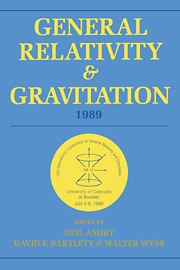 General Relativity and Gravitation, 1989
General Relativity and Gravitation, 1989 Book contents
- Frontmatter
- Contents
- Preface
- Conference committees
- Part A Classical relativity and gravitation theory
- WORKSHOPS
- Part B Relativistic astrophysics, early universe, and classical cosmology
- WORKSHOPS
- B1 Mathematical cosmology
- B2 The early universe
- B3 Relativistic astrophysics
- B4 Astrophysical and observational cosmology
- Part C Experimental gravitation and gravitational wave detection
- WORKSHOPS
- Part D Quantum gravity, superstrings, quantum cosmology
- WORKSHOPS
- Part E Overviews-past, present, and future
B3 - Relativistic astrophysics
Published online by Cambridge University Press: 05 March 2012
- Frontmatter
- Contents
- Preface
- Conference committees
- Part A Classical relativity and gravitation theory
- WORKSHOPS
- Part B Relativistic astrophysics, early universe, and classical cosmology
- WORKSHOPS
- B1 Mathematical cosmology
- B2 The early universe
- B3 Relativistic astrophysics
- B4 Astrophysical and observational cosmology
- Part C Experimental gravitation and gravitational wave detection
- WORKSHOPS
- Part D Quantum gravity, superstrings, quantum cosmology
- WORKSHOPS
- Part E Overviews-past, present, and future
Summary
I shall describe here a few subjects which in my opinion were the most interesting among those presented orally or at the poster session during the Workshop.
1) The (still hypothetical) discovery of a half-millisecond pulsar in the Supernova SN 1987A attracted a lot of attention. It could drastically change our understanding of neutron star physics and in particular our understanding of the equation of state at nuclear densities. In this context models of compact stars involving strange (e.g. bosonic) matter are interesting and important.
2) The classical problem of test particle motion in a given gravitational field experienced a surprising new development: it was claimed that the centrifugal force can be attractive to the axis of rotation and some repulsive phenomena may be connected with gravity!
3) Gravitational radiation found a new astrophysical application: it was suggested that energy and angular momentum losses due to gravitational waves can be equivalent to viscous stresses in thick accretion disks around supermassive black holes. This may be relevant for quasars.
The optical variability with frequency 1968.629 Hz, discovered recently by Middleditch et al. (1989) in the supernova SN 1987A, is now generally interpreted as due to rotation of a neutron star. An alternative possibility, that the reported frequency represents a radial oscillation of the neutron star was discussed at the Workshop by J.R. Ipser and L. Lindblom. They made significant progress in the numerical treatment of the normal-mode pulsation equations by re-expressing these equations in terms of a single potential function.
- Type
- Chapter
- Information
- General Relativity and Gravitation, 1989Proceedings of the 12th International Conference on General Relativity and Gravitation, pp. 253 - 262Publisher: Cambridge University PressPrint publication year: 1990


